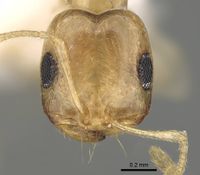Trichomyrmex shakeri
| Trichomyrmex shakeri | |
|---|---|

| |
| Scientific classification | |
| Kingdom: | Animalia |
| Phylum: | Arthropoda |
| Class: | Insecta |
| Order: | Hymenoptera |
| Family: | Formicidae |
| Subfamily: | Myrmicinae |
| Tribe: | Crematogastrini |
| Genus: | Trichomyrmex |
| Species: | T. shakeri |
| Binomial name | |
| Trichomyrmex shakeri Sharaf & Al Dhafer, 2016 | |
This species is considered uncommon. Only six workers were collected in 150 pitfall traps run for one year at the type locality, a relatively pristine section of Wadi Hanifa. Other sampling methods (soil sifting, light traps, beating sheets) were not successful in adding more material. (Sharaf et al. 2016)
Identification
Sharaf et al. (2016) - Among the Arabian Trichomyrmex species, T. shakeri is a conspicuous species, quickly identified by the uniform yellow colour and the exceptionally larger eyes (EL 0.31–0.36 × HW) compared to other sympatric species. Trichomyrmex shakeri is superficially similar to Trichomyrmex santschii from North Africa (Tunisia) in colour and measurements, but it can be readily separated by the absence of the psammophore, which is well-developed in T. santschii.
Keys including this Species
Distribution
Latitudinal Distribution Pattern
Latitudinal Range: 24.9° to 24.9°.
| North Temperate |
North Subtropical |
Tropical | South Subtropical |
South Temperate |
- Source: AntMaps
Distribution based on Regional Taxon Lists
Afrotropical Region: Saudi Arabia (type locality).
Distribution based on AntMaps
Distribution based on AntWeb specimens
Check data from AntWeb
Countries Occupied
| Number of countries occupied by this species based on AntWiki Regional Taxon Lists. In general, fewer countries occupied indicates a narrower range, while more countries indicates a more widespread species. |

|
Estimated Abundance
| Relative abundance based on number of AntMaps records per species (this species within the purple bar). Fewer records (to the left) indicates a less abundant/encountered species while more records (to the right) indicates more abundant/encountered species. |

|
Biology
Castes
Nomenclature
The following information is derived from Barry Bolton's Online Catalogue of the Ants of the World.
- shakeri. Trichomyrmex shakeri Sharaf & Al Dhafer, in Sharaf, Salman, et al. 2016a: 28, fig. 13A-C (w.) SAUDI ARABIA.
- Type-material: holotype worker, 5 paratype workers.
- Type-locality: holotype Saudi Arabia: Riyadh, Wadi Hanifa, 24.90°N, 46.18°E, 814 m., 12.x.2015, pitfall trap (Aldhafer, et al.); paratypes: 1 worker with same data, 4 workers with same data but 806 m., 29.iv.2015.
- Type-depositories: KSMA (holotype); CASC, KSMA (paratypes).
- Diistribution: Saudi Arabia.
Unless otherwise noted the text for the remainder of this section is reported from the publication that includes the original description.
Description
Worker
Holotype TL 2.07; HL 0.62; HW 0.56; SL 0.48; EL 0.19; ML 0.56; PW 0.31; PTL 0.14; PTW 0.09; PPL 0.08; PPW 0.15; CI 90; EI 34; SI 86. Other Workers. TL 1.94–2.33; HL 0.58–0.67; HW 0.52–0.64; SL 0.36–0.48; EL 0.18–0.21; ML 0.53–0.66; PW 0.29–0.34; PTL 0.14–0.18; PTW 0.09–0.13; PPL 0.08–0.15; PPW 0.14–0.18; CI 85–96; EI 31–37; SI 68–86 (n = 5).
Head. Slightly longer than broad and broader anteriorly than posteriorly, with emarginated posterior margin and feebly convex sides; anterior clypeal margin nearly straight or feebly convex; eyes large (EL 0.31–0.36 × HW), with 11 ommatidia in longest row; scapes when laid back from their insertions surpassing posterior margin of head by about one third of eye length.
Mesosoma. Promesonotum distinctly convex in profile; metanotal groove impressed.
Pilosity. Underside of head with few short straight hairs, not forming a psammophore; cephalic surface and mandibles with sparse short hairs, anterior clypeal margin with a median long hair and two pairs of long hairs on each side; antennae with dense appressed pubescence; mesosoma without hairs except for few sparse appressed pubescence on promesonotum.
Petiole. With one pair of long, backward directed hairs.
Postpetiole. With two pairs; first gastral tergite bare except for few sparse appressed pubescence, the remaining gastral tergites with some long hairs.
Sculpture. Cephalic surface smooth and shining except posterior margin of head, area in front of eyes and mandibles longitudinally rugulose; promesonotal dorsum faintly irregularly sculptured; mesopleura, propodeum, petiole and postpetiole densely punctulate-reticulate; gaster smooth and shining.
Colour. Uniform yellow, eyes black, mandibular teeth dark brown.
Type Material
Holotype. Saudi Arabia : worker, Riyadh, Wadi Hanifa, 24.90˚ N, 46.18˚ E, alt. 814 m, 12 Oct. 2015, Aldhafer et al. leg. (King Saud Museum of Arthropods). Paratypes. Saudi Arabia : 1 w, same data as the holotype (KSMA); 4 w, Riyadh, Wadi Hanifa, 24.90˚ N, 46.18˚ E, alt. 806 m, 29 Apr. 2015, Aldhafer et al. leg. (1 in California Academy of Sciences: CASENT0922068; 3 in KSMA). Type material is collected by pitfall traps.
Etymology
The new species has been named in honor of the late Egyptian writer Mahmoud M. Shaker (1909–1997).
References
- Sharaf, M.R., Salman, S., Al Dhafer, H.M., Akbar, S.A., Abdel-Dayem, M.S. & Aldawood, A.S. 2016. Taxonomy and distribution of the genus Trichomyrmex Mayr, 1865 (Hymenoptera: Formicidae) in the Arabian Peninsula, with the description of two new species. European Journal of Taxonomy 246:1-36 (doi:10.5852/ejt.2016.246).
References based on Global Ant Biodiversity Informatics
- Sharaf M. R., S. Salman, H. M. Al Dhafer, S. A. Akbar, M. S. Abdel-Dayem, A. S. Aldawood. 2016. Taxonomy and distribution of the genus Trichomyrmex Mayr, 1865 (Hymenoptera: Formicidae) in the Arabian Peninsula, with the description of two new species. European Journal of Taxonomy 246: 1–36

